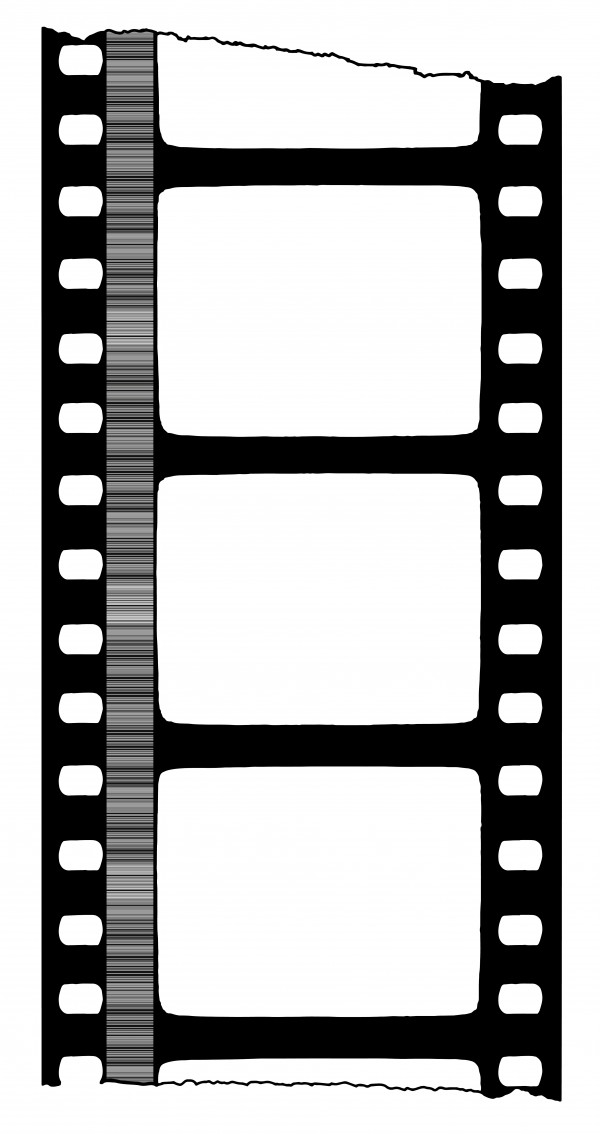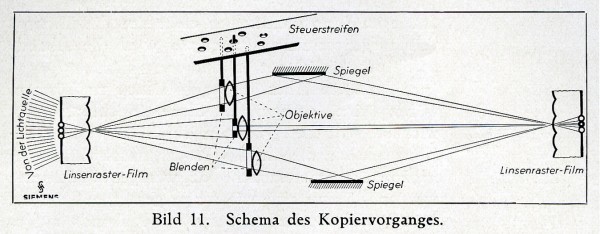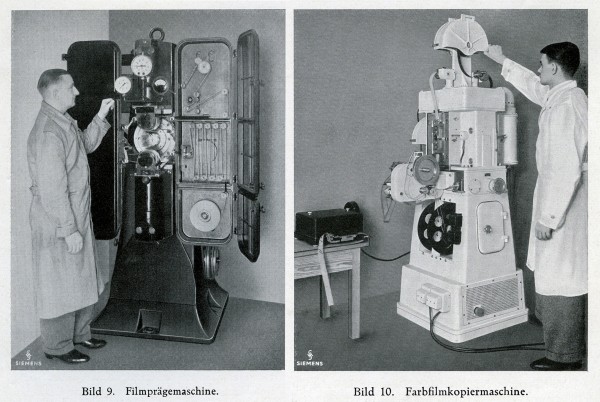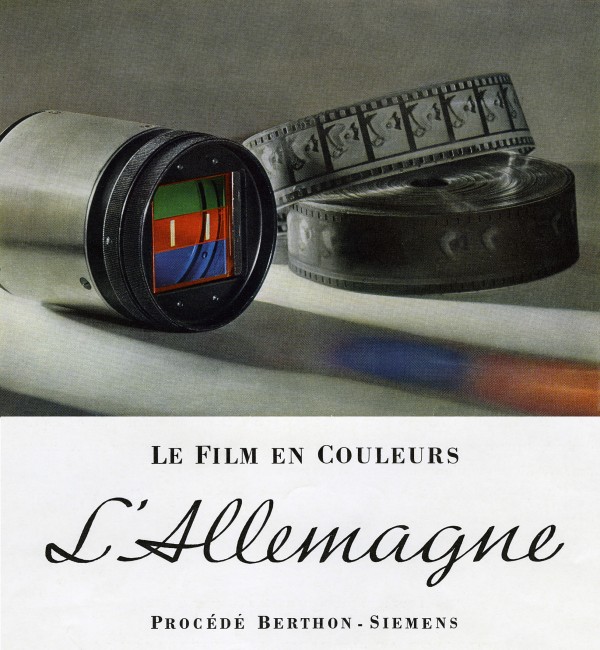An additive three-color lenticular screen process used in Germany during the 1930s that used lenticular reversal film for both shooting and making prints.
Film Explorer

Berthon-Siemens lenticular prints were on 35mm reversal stock. These prints were B/W – the color was revealed on-screen during projection.
Design by Christian Zavanaiu.
Identification
Approx. 22.05mm x 13.49mm (0.868 in x 0.531 in).
Panchromatic B/W reversal, embossed on the base side of the film, manufactured by Perutz. 24 horizontal microlenses per mm (610 per in); horizontal orientation.
Unknown. As this was a reversal print, the edges were black.
1
While the lenticular camera reversal film and prints appeared B/W, the full color image was revealed in projection.
Unknown
Prints contained an optical soundtrack, most likely variable density.
Unknown
Panchromatic B/W reversal, embossed on the base side of the film, manufactured by Perutz. 24 microlenses per mm (610 per in); horizontal orientation.
Unknown. As this was a reversal film, the edges were black.
History
[This entry is a continuation of Keller-Dorian.]
In 1929, motion picture inventor Rodolphe Berthon launched the company La Société Française Cinéchromatique (SFC), to compete against the lenticular color film company Keller-Dorian. This decision came after the Keller-Dorian company had sidelined the inventor, in 1924, from his own invention.
As a number of key lenticular patents were due to expire around this time, SFC’s future prospects were looking bleak, and several companies outside of France began to demonstrate an interest in the technology.
In 1931, a former director and cinematographer Carl Louis Gregory, who was working as a research engineer for the American Kislyn Corporation, met Rodolphe Berthon in his laboratory in Neuilly-sur-Seine, Paris. An agreement was promptly concluded for the exploitation of the process in the United States – but only a year later, the Kislyn research laboratory was shuttered.
In Germany, in 1930, a consortium headed by Siemens & Halske AG, Opticolor AG and Perutz-Photowerke GmbH, secured licenses to work with, and further develop, the French lenticular process. Rodolphe Berthon sent René Pommier, an engineer from SFC, to collaborate with the research team at the consortium’s laboratory in Spandau, Berlin. From 1931, they continued research to achieve the ability to produce lenticular release prints on an industrial scale. It took five years for the Siemens-Halske technicians to succeed in producing good-quality embossed prints, at an affordable price point.
In 1933, the German film industry came under the jurisdiction of Dr. Joseph Goebbels – Nazi Propaganda Minister and head of the Reich Ministry of Public Enlightenment and Propaganda. Goebbels closely followed the technical development of color film in the country, presumably seeking prestige for the Reich as well as seeing color’s potential for enhancing Nazi propaganda. Goebbels began pressuring Siemens & Halske (and other German film manufacturers) to devise a color film process that could compete with Technicolor.
August 4, 1936, saw the screening of the first fiction film in color shot using the new Siemens-Opticolor process – Das Schönheitsfleckchen, directed by Rolf Hansen, based on a short story by Alfred de Musset. The screening date was carefully timed, falling four days after the official opening of the Olympic Games in Berlin – hence, the film enjoyed considerable international attention. The film, which was enthusiastically received by the public, was widely reported in the Berlin press. But the praise was not unanimous – according to several experienced technicians who attended the screenings, the colors lacked saturation and definition was poor.
In 1936, Agfa began marketing Agfacolor Neu, a 16mm chromogenic reversal film stock for amateur color market. This subtractive process was truly innovative, boasting better color saturation and higher definition. Numerous experts consulted at the time, judged the new Agfacolor process far superior to the lenticular system, and concluded that subsequent color research should pursue this new direction. Goebbels and Karl Hanke, his secretary at the Ministry for Public Enlightenment and Propaganda (colloquially known as the Propagandaministerium) instructed Agfa to commence rapid development of a negative-positive motion picture process, suitable for mass distribution. Siemens-Halske promptly withdrew from the game, and, by November 1938, the Spandau laboratory had ceased all activity.
Selected Filmography
Adapted from a short story by Alfred de Musset. The film depicts a meeting between a 20-year-old knight and the Marquise de Pompadour at Trianon, Palace of Versailles. Now considered a lost film.
Adapted from a short story by Alfred de Musset. The film depicts a meeting between a 20-year-old knight and the Marquise de Pompadour at Trianon, Palace of Versailles. Now considered a lost film.
A short propaganda film. Winner of the International Jury’s Grand Prix at the Exposition Universelle in Paris, 1937.
A short propaganda film. Winner of the International Jury’s Grand Prix at the Exposition Universelle in Paris, 1937.
A short propaganda film.
A short propaganda film.
Technology
Siemens’s objective was to improve the Keller-Dorian process and to exploit it at an industrial scale. Research work began in 1931 and was completed in 1936. The development involved 50 laboratory technicians, working under the direction of Dr. Fritz Fischer and the optics engineer Kurt Räntsch.
Shooting
The lenticular film process developed by Siemens & Halske exactly replicated the Keller-Dorian process. A three-color filter (Blue, Red, Yellow) was mounted on the front lens of the camera and panchromatic reversal film was used. The image was exposed through the film base, onto which was embossed a linear array of semi-cylindrical microlenses, or lenticules. The combination of the tricolor banded filter and the microlenses allowed the recording of three separate color records – from which a full color image could be reconstituted in projection – on the B/W emulsion.
Lenticular film stock
According to Siemens & Halske technical specifications, the embossing pitch used was 24 horizontal microlenses per mm, with a 32µm (0.032mm) radius of curvature, embossed to a depth of only 4µm (0.000157 in). These specifications provided a vertical resolution of 384 lines across the frame from top to bottom. Perutz, a German film manufacturer, developed a special lenticular reversal emulsion, with high resolving power, produced on an embossing machine that automatically produced the lenticular grids with great precision.
Because the three-color filter in front of the camera lens absorbed a considerable amount of light, the film emulsion needed to be hypersensitized (providing increased sensitivity to light). René Pommier successfully developed a hypersensitization formula based on potassium thiocyanate, rather than the traditional ammonia.
Printing
The printing process was generally regarded as posing insurmountable difficulties for lenticular films. Attempts by Keller-Dorian and Cinéchromatique to contact print, from one lenticular copy to another, were unsuccessful in the late 1920s. This was because bringing the two lenticular screens into contact inevitably resulted in unpredictable moiré effects (an obtrusive interference pattern resulting from the improper superimposition of the two line screens). The key innovation of the Siemens process was a claim to have done away with moiré interference. Kurt Räntsch designed a printing machine based on an entirely new design. The three color records, interleaved as thin stripes on the lenticular film emulsion, were separated and then recombined by a three-lens optical system. The monochromatic light transmitted to each lens could be modulated by a form of “light valve,” allowing control of precise color grading.
Early in 1935, Siemens began production on an industrial scale, fully equipping the Geyer laboratory in Munich with developing and printing machines.
Projecting
The Siemens engineers had a further problem to overcome: the loss of light through the three-color filter required more powerful carbon arc lights for large-screen projection. So, the company registered a patent in 1935 (DE724430C) for doubling the intensity of the carbon arc lamp, while also devising a special aluminum screen with greater reflectivity.
No theaters were equipped with a fixed installation for showing lenticular color films. Das Schönheitsfleckchen (1936) was shown at the UFA Pavillon in Berlin, and later at the Urania in Vienna, Austria. Propaganda films were projected in Munich at The Kammerlichtspiel (600 seats). For the National-Socialist party congress, the film Nürnberg 1937 (1937) was projected on a 9.6m x 7.2m (31.50 ft x 23.62 ft) aluminum screen in the Deutsches Museum, Munich. The press reported that there were over 2,000 people in attendance.

Illustrations from a 1936 Siemens leaflet, showing details of lenticular film structure and a microscopic cross section.
Paul Storch (1936). “Das Berthon-Siemens Farbfilmverfahren”. Siemens Zeitschrift, 9 (Sept.): Berlin.

Shooting and projecting with the lenticular process.: These illustrations show the path of light through the filters. Fig. 1: When photographing a white flower, the three RGB filters allowed light to pass, exposing the sensitive layer. Fig. 2: With a yellow flower, only R & G channels exposed the sensitive layer; the blue filter did not transmit light because the object does not emit blue radiation. Figs 3 and 4: The same demonstration is shown for projecting the film.

The sophisticated design of the optical printer made it possible to adjust the intensity of each primary color separately. The printing lights were recorded on perforated strips.
Storch, Paul (1936). “Das Berthon-Siemens-Farbfilmverfahren”. Siemens Zeitschrift, 16 (Sept.): Berlin.

Diagram of the optical printing process developed by Siemens-Halske.
Courtesy of François Ede.

Film embossing and printing machines.
Storch, Paul (1936). “Das Berthon-Siemens-Farbfilmverfahren”. Siemens Zeitschrift, 16 (Sept.): Berlin.
References
Alt, Dirk (2013). Der Farbfilm marchiert! Frühe Farbfilmverfahren und NS-Propaganda 1933–1945. München: Belleville Verlag.
Ede, François (2013). “The Keller-Dorian Process and lenticular film: An Episode in the History of Film Color”. 1895, 71 (Winter).
Gretener, Edgar (1937). “A Brief Survey of the Physics and Technology of the Berthon Siemens Color Process”. Journal of the SMPE, 28:5 (May): pp. 447–63.
Le Guern, Nicolas (2017). “Des recherches de Rodolphe Berthon chez Pathé sur le cinéma en couleurs naturelles en 1913-1914 au procédé lenticulaire Kodacolor”. In Recherches et innovations dans l'industrie du cinéma, Stéphanie Salmon & Jacques Malthête (eds), pp. 225–41. Paris: Fondation Jérôme Seydoux-Pathé.
Storch, Paul (1936). “Das Berthon-Siemens-Farbfilmverfahren [The Berthon-Siemens color process]”, according to a lecture given on July 21, 1936, to representatives of the technical press at the Schaltwerk Hochbau of Siemenswerke. Siemens Hefte /Siemens newsletter, Siemens & Halske- Siemens -Schuchertwerke AG, 9 (September): pp. 329–34.
Patents
Siemens & Halske & Kurt Rӓntsch. Filmzieher für Linsenrasterfilme. German Patent D.R.P N°752,530, November 10, 1934.
Siemens & Halske & Fritz Fischer. Method for reproducing sound recordings applied to the layer side of lenticular films. US patent DE655697C, filed August 4, 1931, and issued January 20, 1938. https://patents.google.com/patent/DE655697C
Siemens & Halske & Fritz Fischer. Process for producing lenticular films by means of embossing rolls. German Patent DE571003C, filed September 25,1931 and issued February 22, 1933. https://patents.google.com/patent/DE571003C
Rӓntsch, Kurt & Hans Arni. Device for copying images on lenticulated films. US patent US2070179, filed November 10, 1934, and issued February 9, 1937. https://patents.google.com/patent/US2070179A
Preceded by
Compare
Related entries
Author
François Ede is a cinematographer and a documentary filmmaker. He has restored several films shot with the Keller-Dorian process, including Jour de fête in 1994 and recently carried out the reconstruction and restoration of Abel Gance's La Roue (1923) for the Jérôme Seydoux-Pathé Foundation.
Ede, François (2025). “Berthon-Siemens”. In James Layton (ed.), Film Atlas. www.filmatlas.com. Brussels: International Federation of Film Archives / Rochester, NY: George Eastman Museum.



